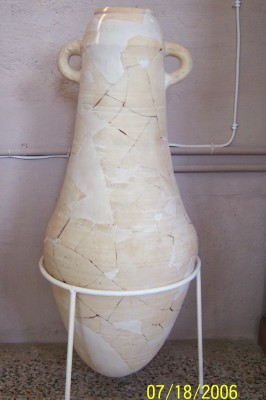|
The content on this website is maintained by
Robert Myallis, pastor at Zion's Lutheran Church, of Jonestown, PA.
The photos were taken by
Emily Myallis, a diaconal minister in the ELCA who also serves at Zion's Lutheran.
This website and travel to
Greece was made possible by a grant from the
Fund for Theological Education,
which provides grants to assist the education and formation of
Christian leaders from numerous denominations.
Bible quotes are taken from the New
Revised Standard Version, unless cites otherwise.
The above photo of Greece comes from
NASA; The icon of Saint Paul comes from George Mitrevski's website. |
 |
|
Clay
Jars
 This
is a picture of a clay jar found in the excavations at Corinth.
They are numerous clay jars from various periods. This jar was
not found in one piece and has been reconstructed. The lighter
white is the work of the modern archeologist. This
is a picture of a clay jar found in the excavations at Corinth.
They are numerous clay jars from various periods. This jar was
not found in one piece and has been reconstructed. The lighter
white is the work of the modern archeologist.
How are clay jars significant for understanding the world of Paul?
Paul uses clay Jars to describe the suffering he and his fellow
Christians are undergoing:
But we have this treasure in jars of clay to show that this
all-surpassing power is from God and not from us. We are hard
pressed on every side, but not crushed; perplexed, but not in
despair; persecuted, but not abandoned; struck down, but not
destroyed. (Second letter to the Corinthians, chapter 4:7-9)
 How is Paul remixing his culture?
How is Paul remixing his culture?
Paul takes an everyday item
where people would store their treasures (banks did not exist
yet!) and turns it into a metaphor for the Christian life. Clay
jars can hold something for years but are also fragile.
|
|



 This
is a picture of a clay jar found in the excavations at Corinth.
They are numerous clay jars from various periods. This jar was
not found in one piece and has been reconstructed. The lighter
white is the work of the modern archeologist.
This
is a picture of a clay jar found in the excavations at Corinth.
They are numerous clay jars from various periods. This jar was
not found in one piece and has been reconstructed. The lighter
white is the work of the modern archeologist.